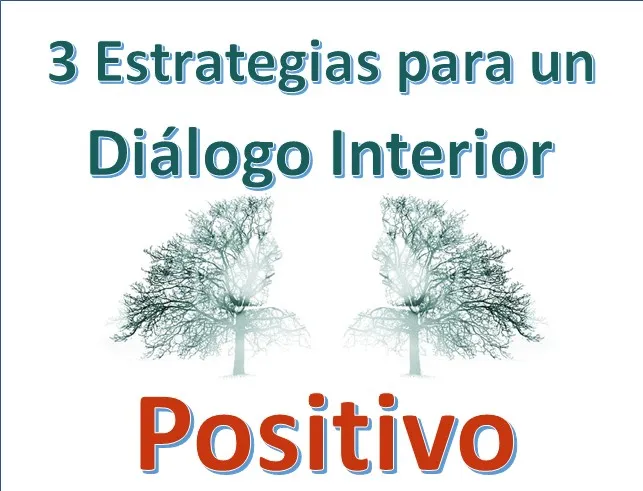
Anoche, miércoles 18 de agosto, tuve la oportunidad de compartir experiencias en el programa Coordenadas de Bienestar conducido por nuestra apreciada amiga @miriannalis a través del canal de la comunidad @hispapro. Una experiencia grata, llena de apoyo de un grupo de personas que con su presencia y comentarios creamos una interacción de alta vibra, caminamos juntos hacia el bienestar interior. Para todos gracias, un abrazote lleno de cariño y agradecimientos.

El diálogo interior
Los diálogos internos, esa conversación constante que tenemos con nosotros mismos y que muchas veces esta enmarcada en pensamientos negativos, fue el tema trabajado. Unos diálogos que surgen de nuestras percepciones, creencias, expectativas perfilando la relación que tenemos con nosotros mismos y con los demás. Hay cuatro tipos de pensamientos negativos que nos llevan a mantener estas convenciones internas poco saludables, estos son:
A.- Criticarte:
Es un dialogo que tiende a enfocarnos en nuestras debilidades. En él nos decimos cosas como: Tu siempre tan impulsiva ¿Cuándo vas a aprender?; pareces loca, tonta, débil, insegura, indecisa o cualquier otra palabra que te descalifica.
B.- Juzgarte:
Apunta hacia la recriminación de nuestras acciones a aquello que hicimos o dejamos de hacer, por lo general expresa vergüenza e impotencia. Con frecuencia estas en este diálogo cuando te dices: ¿Por qué hice eso?; si le hubiese dicho, si hubiese hecho… Lo cual pertenece al pasado lo que hace que sea inmodificable por lo que no tiene mucho sentido mantenerse en él.
C.- La victima:
El “juego” de la víctima es no asumir responsabilidades, lo que sucede y el cómo te sientes encuentra su justificación en las acciones del otro o en las circunstancias.
D.- El pensamiento apocalíptico o catastrófico
el futuro siempre se asoma peor que el presente: Cualquier síntoma te ubica en una enfermedad grave, algún detalle te lleva a generalizar sobre la maldad de las personas, en línea general, el mundo es un lugar inhóspito.

Que nuestros diálogos internos transiten por estas vías es estar en la predisposición al mal-estar lo cual traspasa el ámbito pensamiento, manifestándose en nuestras actitudes, lenguaje y acciones, en otras palabras, en el pensamiento nace todo. Si nosotros deseamos transformar nuestra relación con nosotros mismos y con los demás un buen comienzo es tener un diálogo interno más positivo, creativo, que a fin de cuentas, lo que significa es reconocernos y tratarnos mejor.
Para ello es importante comprender y tratar los pensamientos como entes independientes, sin embargo, son tuyos, tu los creas por lo que puedes conducirlos y llevarlos por donde tu quieres. Cuando nos damos cuenta y somos conscientes de ese dialogo interior negativo hay que buscar de romper la dinámica. Algunas estrategias para trabajar en ello son:
A.- Habla con tu pensamiento:
Pregúntale ¿Qué quiere, qué hace allí? Hazle ver que tanto él como tú saben que ya eso paso y no puedes hacer nada al respecto, lo que si puedes y quieres es pasar la página; o pregúntale de qué sirve si los dos están claros que eso pertenece al futuro por lo tanto no lo conocen, es impredecible, cambiante, por lo que tampoco tiene sentido que sigan en ese “discusión”. En cualquier caso la idea es ponerle un “hasta aquí”. Si te sigue visitando, porque a veces es persistente, cada vez que toque la puerta, repítele: te dije hasta aquí, así que no me engancho, chao y busca un pensamiento o acción agradable que lo sustituya. Eso no lleva al segunda estrategia.
B.- Ponle sonido y color a tus pensamientos
Agarra el pensamiento, colócale el sonido y color que menos te gusten para que lo reconozcas apenas llegue. Busca pensamientos contrastantes y construye una frase positiva, colócale una música y color que te resulten agradables. Por ejemplo: el diálogo que entablas es relacionado con la salud. Tu frase puede ser: soy sana, soy saludable, mi cuerpo se encuentra en armonía, vivo en sosiego. Pinto la frase que resuena conmigo de calor violeta como símbolo de sanación. En lo que llega el negativo lo sustituyo por el positivo.
3. Crea diálogos conscientes
Tómate unos minutos cada día y conversa contigo sobre lo bien que estas haciendo algo, de lo satisfecho que te sientes con tus logros, enfócate en un tema para evitar la generalización, se concreto en eso que te estas reconociendo y, sobre todo, llénate de esa emoción positiva que da el logro.

Sobre este punto fue el comentario de cierre. Cada acción que realicemos tenemos que hacerla desde lo sentido. “No se vale” repetir frases o conversaciones monótonas. De la misma manera que actúa el diálogo negativo que cuando lo entablamos nos baja la vibra, nos altera el corazón al estar referido a un momento desagradable determinado y nos dejamos afectar, de igual manera, tiene que ser este diálogo interno positivo, algo que nos llene de energía positiva de emoción sabrosa, que nos impulse y nos motive, encontrando en él, una fuente de bienestar interior.

En Inglés
Last night, Wednesday August 18, I had the opportunity to share experiences in the program Coordenadas de Bienestar hosted by our dear friend @miriannalis through the community channel @hispapro. A pleasant experience, full of support from a group of people who with their presence and comments created a high vibrational interaction, we walked together towards inner wellness. To all of you thank you, a hug full of love and gratitude.

The inner dialogue
The inner dialogues, that constant conversation we have with ourselves and that many times is framed in negative thoughts, was the theme we worked on. Dialogues that arise from our perceptions, beliefs, expectations outlining the relationship we have with ourselves and with others. There are four types of negative thoughts that lead us to maintain these unhealthy internal conventions, these are:
A.- Criticizing ourselves:
It is a dialogue that tends to focus on our weaknesses. In it we tell ourselves things like: You are always so impulsive, when are you going to learn; you look crazy, silly, weak, insecure, indecisive or any other word that disqualifies you.
B.- Judging you:
Aims at the recrimination of our actions to what we did or did not do, usually expresses shame and helplessness. You are often in this dialogue when you say to yourself: Why did I do that; if I had told him, if I had done... This belongs to the past, which makes it unchangeable, so it does not make much sense to stay in it.
C.- The victim
The "game" of the victim is not to assume responsibilities, what happens and how you feel finds its justification in the actions of the other or in the circumstances.
D.- Apocalyptic or catastrophic thinking:
The future always looks worse than the present: Any symptom places you in a serious illness, some detail leads you to generalize about the wickedness of people, in general line, the world is an inhospitable place.

That our internal dialogues go through these ways is to be in the predisposition to the bad-being which goes beyond the field of thought, manifesting itself in our attitudes, language and actions, in other words, everything is born in thought. If we wish to transform our relationship with ourselves and with others, a good start is to have a more positive, creative internal dialogue, which in the end, what it means is to recognize ourselves and treat ourselves better.
To do this it is important to understand and treat thoughts as independent entities, however, they are yours, you create them so you can drive them and take them where you want. When we realize and are aware of this negative inner dialogue we must seek to break the dynamic. Some strategies to work on it are:
A.- Talk to your thoughts:
Ask him what he wants, what is he doing there? Make him/her see that both he/she and you know that this has already happened and you cannot do anything about it, what you can and want is to turn the page; or ask him/her what is the point if both of you are clear that this belongs to the future, therefore you do not know it, it is unpredictable, changeable, so it does not make sense to continue in this "discussion". In any case, the idea is to put a "so far". If he keeps visiting you, because sometimes he is persistent, every time he knocks on the door, repeat: I told you so far, so I'm not hooked, bye and look for a pleasant thought or action to replace it. This does not lead to the second strategy.
B.- Put sound and color to your thoughts
Take the thought, put the sound and color you like the least so that you recognize it as soon as it arrives. Look for contrasting thoughts and build a positive sentence, add music and color that you find pleasant. For example: the dialogue you engage in is related to health. Your phrase can be: I am healthy, I am healthy, my body is in harmony, I live in peace. I paint the phrase that resonates with me with violet warmth as a symbol of healing. As soon as the negative comes, I replace it with the positive.
3. Create conscious dialogues
Take a few minutes every day and talk to yourself about how well you are doing something, how satisfied you feel with your achievements, focus on a topic to avoid generalization, be concrete in what you are recognizing and, above all, fill yourself with that positive emotion that gives the achievement.

On this point was the closing comment. Every action we take must be based on meaning. "It is not worth repeating monotonous phrases or conversations. In the same way that negative dialogue acts, when we engage in it, it lowers our vibration, it alters our heart when it refers to a certain unpleasant moment and we let it affect us, in the same way, this positive internal dialogue has to be something that fills us with positive energy of tasty emotion, that drives us and motivates us, finding in it, a source of inner wellbeing.
Translated with www.DeepL.com/Translator (free version)
Fuente de imágenes: Portada - 2 . - 3Editada en PowerPoint - 4



MIS REDES SOCIALES






Te invito a apoyar este proyecto como witnes y a formar parte de esta gran comunidad uniéndote a su Discord en el siguiente enlace:
Discord de la comunidad Cervantes




